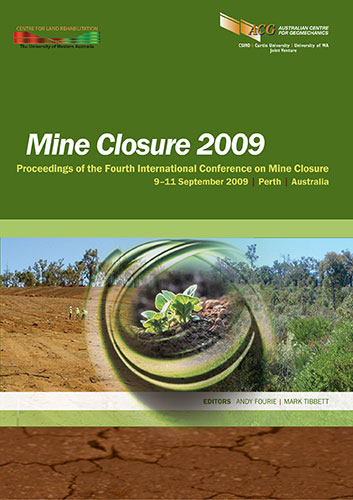Mine closure or mind closure — are mining companies meeting their whole of life cycle, triple bottom line obligations?

|
Authors: Lambeck, RJ Paper is not available for download Contact Us |
DOI https://doi.org/10.36487/ACG_repo/908_Lambeck
Cite As:
Lambeck, RJ 2009, 'Mine closure or mind closure — are mining companies meeting their whole of life cycle, triple bottom line obligations?', in AB Fourie & M Tibbett (eds), Mine Closure 2009: Proceedings of the Fourth International Conference on Mine Closure, Australian Centre for Geomechanics, Perth, pp. 13-19, https://doi.org/10.36487/ACG_repo/908_Lambeck
Abstract:
While mine closure has traditionally be seen as the cleaning up job at the end of the extraction process, community expectations of industries that impact significantly on the environment and society are changing. Meeting these expectations requires a change of mindset to one where mine closure is seen as one component of a whole of life cycle obligation to maximise positive environmental and social consequences of the mining endeavour. This involves a shift from models of trade-off to ones of net benefit across the three pillars of sustainability — environment; society; and economy. Can companies legitimately claim that, as a consequence of their existence, the world is environmentally and socially, as well as economically, better off? Aspirations to be able to make such claims requires managing the company’s footprint — avoiding, minimising or offsetting social and environmental impact across the whole of its operations and life cycle, not simply cleaning up the mess at the mine. From this perspective, the technical challenges of mine closure must be considered as one part of a portfolio of responsibilities which includes a serious commitment to corporate social responsibility as well as to whole of business environmental impact, locally and globally. In this paper partnerships between Greening Australia and a number of major corporations are used to illustrate a range of opportunities for the mining sector to demonstrate that they are good corporate citizens seeking to maximise net environmental and social, as well as economic, benefit.
References:
Commonwealth Government (2009) Greenhouse Friendly™, viewed 12 May 2009,
Myers, N. (2003) Biodiversity Hotspots Revisited, BioScience, Vol. 53:10, pp. 916–917.
© Copyright 2025, Australian Centre for Geomechanics (ACG), The University of Western Australia. All rights reserved.
View copyright/legal information
Please direct any queries or error reports to repository-acg@uwa.edu.au
View copyright/legal information
Please direct any queries or error reports to repository-acg@uwa.edu.au